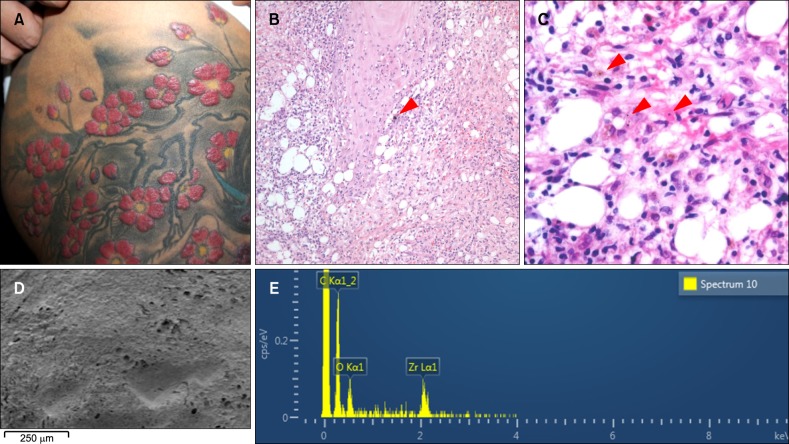Ann Dermatol.
2017 Dec;29(6):824-826. 10.5021/ad.2017.29.6.824.
Tattoo Granuloma Restricted to Red Dyes
- Affiliations
-
- 1Department of Dermatology, Chung-Ang University College of Medicine, Seoul, Korea. ksli0209@cau.ac.kr
- 2Department of Dermatology, Inje University Seoul Paik Hospital, Inje University College of Medicine, Seoul, Korea.
- 3Department of Medicine, Chung-Ang University College of Medicine, Seoul, Korea.
- 4Department of Pathology, Chung-Ang University College of Medicine, Seoul, Korea.
- KMID: 2395205
- DOI: http://doi.org/10.5021/ad.2017.29.6.824
Abstract
- No abstract available.
MeSH Terms
Figure
Reference
-
1. Mortimer NJ, Chave TA, Johnston GA. Red tattoo reactions. Clin Exp Dermatol. 2003; 28:508–510. PMID: 12950341.
Article2. Skelton HG 3rd, Smith KJ, Johnson FB, Cooper CR, Tyler WF, Lupton GP. Zirconium granuloma resulting from an aluminum zirconium complex: a previously unrecognized agent in the development of hypersensitivity granulomas. J Am Acad Dermatol. 1993; 28:874–876. PMID: 8491884.
Article3. Muñoz JA, Campaña AM, Barrero FA. Effect of cationic micelles on the formation of the complex oxalate-Alizarin Red S-Zr(IV) Application to the sensitive fluorescence determination of oxalate ion. Talanta. 1998; 47:387–399. PMID: 18967340.
- Full Text Links
- Actions
-
Cited
- CITED
-
- Close
- Share
- Similar articles
-
- A Case of Foreign Body Granulomatous Reaction to a Red Lip Cosmetic Tattoo Successfully Treated with Carbon Dioxide Laser
- A Case of Granulomatous Reactions to a Permanent Red Tattoo
- Removal of a red tattoo on the lips using a 532-nm picosecond laser
- Treatment of a refractory allergic reaction to a red tattoo with the combination of picosecond neodymium-doped yttrium aluminum garnet laser, fractional carbon dioxide laser, and corticosteroid intralesional injections: a case report
- Two Cases of Tattoo Reaction


